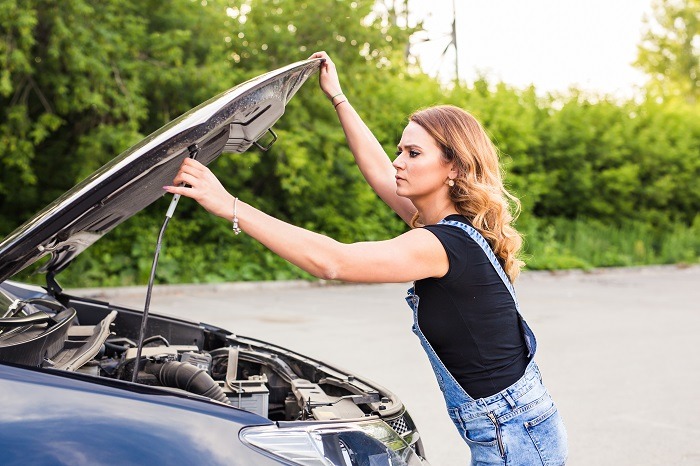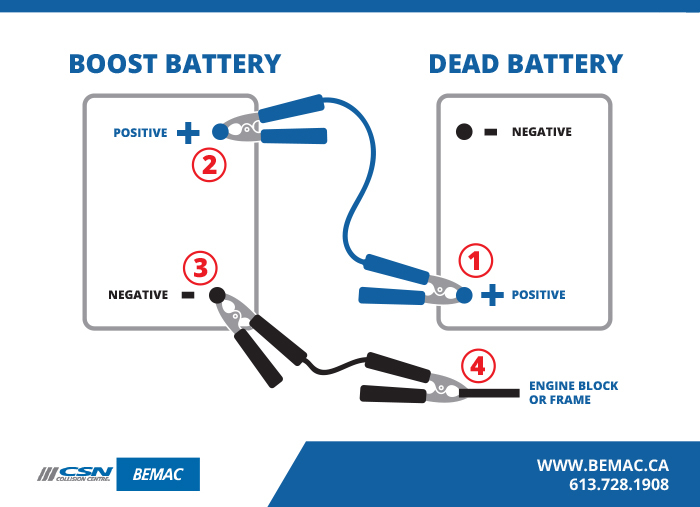
You just got in your car, ready to head to your next destination. You turned the key in the ignition and… nothing.
That silence sounds like a dead battery. We’ve all been there, and it’s majorly frustrating.
But the good news is that with the right tools and the right safety precautions, you can bring that dead battery back to life.
Take the Necessary Safety Precautions First
Jumping a car involves popping the hood and working with the engine/battery, and you should always take the proper safety precautions.
- Read your car’s manual in case there are special instructions.
- Make sure you understand how to correctly attach the clamps on you jumper cables to avoid damage or electrical shock.
- Keep small children and other people away from the area while you’re jumping your car.
- Wear gloves and safety glasses when you begin the process.
Do Not Jump-Start Your Car If the Battery is Cracked or Leaking
You should never try to jump start your car if your battery is cracked, visibly leaking acid, or bulging. This means your battery needs a fully replacement, and you should book an appointment with us.
If you’ve closely and carefully inspected your battery, and it looks safe and intact, you can proceed.
If You Don’t Feel Comfortable Jumping Your Car, Call Us
It’s always better to be safe than sorry, particularly when it comes to your car. If you don’t feel comfortable jumping your battery, or don’t have anyone with another car to help you, call us!
Jump-Starting a Dead Battery
What You Need
- Jumper cables
- Another car
- Space
#1: Inspect Your Jumper Cables
First, pull out your red and black jump cables and inspect them carefully. There should be 2 working clamps per cable, and no fraying or cracked wire insulation.
#2: Get the Helper Car Into Position
The helper car should ideally be facing the front of the dead vehicle. Your cars should not be touching, but cables should easily reach between the batteries.
Depending on where your car battery died, you may not be able to get another vehicle up close enough to jump start it. In that case, calling a professional will be the best course of action.
#3: Put Both Vehicles in Park and Shut Off the Ignition
Neither of the vehicles should be running at this step. Standard transmission vehicles should be put in neutral.
#4: Attach One Red Clamp to the Positive Terminal of the Dead Battery
Once you’ve remove the protective coverings from the battery terminals (they’ll be marked with a big ‘+’ and ‘–’), you can firmly attach one clamp to the positive terminal on the dead battery.
Do not touch the metal parts of the clamps when they are attached to the vehicles. They’re conducting electricity, and you’d get shocked.
#5: Attach the Second Red Clamp to the Positive Terminal of the Helper Car’s Battery
It’s the same as step #4, but on the other vehicle.
#6: Attach One Black Clamp to the Negative Terminal of the Helper Car’s Battery
Now the black cable comes into play – but make sure to attach the first clamp to the helper car’s negative battery terminal first.
#7: Attach the Second Black Clamp to an Unpainted Metal Surface On Your Car
The last clamp doesn’t actually touch the battery – instead it helps ground the electrical current. Your engine block has unpainted metal – like nuts – that will work.
Any piece of unpainted metal you do choose should be a decent distance away from the battery itself.
At this point, your batteries and cables should look like this:

If they don’t, go through steps #1-7 again and make sure everything is correct before proceeding to step #8.
#8: Start the Ignition on the Helper Car
Turn on the helper car and let it run for 30-60 seconds by itself. Leave it running – with the driver in the car – and proceed to the next step.
#9: Start the Car with the Dead Battery
Now you can try starting your car. Your battery should hold a charge and your engine should turn over.
If the Jump Start Works
Congratulations – you’ve officially jumped your car battery!
Once you get your car running, don’t turn it off. Leave it in park, and remove the jumper cables in reverse order. Start with the black clamps, then move to the red.
Then replace the protective coverings over your battery terminals, and close the hood of your car. At this point the helper car is free to go – make sure to thank the driver profusely!
You should drive your car around for 10-15 minutes to help it charge back up.
I Did This, But the Next Time I Tried to Start My Car, It Was Dead – Why?
This means that your battery can no longer hold a charge, and should be replaced.
If the Jump Start Doesn’t Work
If the jump start doesn’t work, your battery will need to be replaced. Bemac can come get your car and replace your battery so you’ll be back on the road as quickly and safely as possible.








